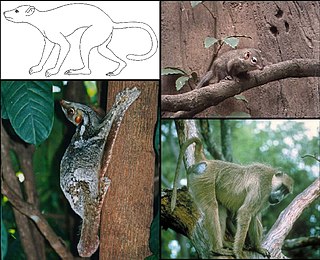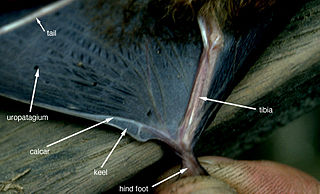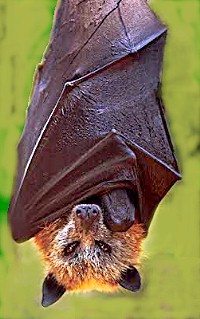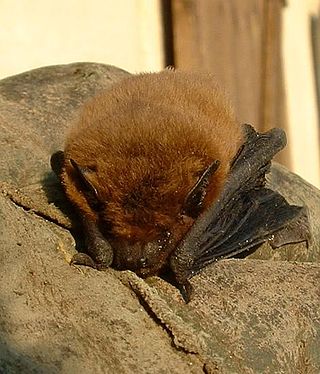Related Research Articles

The treeshrews are small mammals native to the tropical forests of South and Southeast Asia. They make up the entire order Scandentia, which split into two families: the Tupaiidae, and the Ptilocercidae.

Echolocation, also called bio sonar, is a biological active sonar used by several animal groups, both in the air and underwater. Echolocating animals emit calls and listen to the echoes of those calls that return from various objects near them. They use these echoes to locate and identify the objects. Echolocation is used for navigation, foraging, and hunting prey.

Microbats constitute the suborder Microchiroptera within the order Chiroptera (bats). Bats have long been differentiated into Megachiroptera (megabats) and Microchiroptera, based on their size, the use of echolocation by the Microchiroptera and other features; molecular evidence suggests a somewhat different subdivision, as the microbats have been shown to be a paraphyletic group.

Megabats constitute the family Pteropodidae of the order Chiroptera (bats). They are also called fruit bats, Old World fruit bats, or—especially the genera Acerodon and Pteropus—flying foxes. They are the only member of the superfamily Pteropodoidea, which is one of two superfamilies in the suborder Yinpterochiroptera. Internal divisions of Pteropodidae have varied since subfamilies were first proposed in 1917. From three subfamilies in the 1917 classification, six are now recognized, along with various tribes. As of 2018, 197 species of megabat had been described.

Vespertilionidae is a family of microbats, of the order Chiroptera, flying, insect-eating mammals variously described as the common, vesper, or simple nosed bats. The vespertilionid family is the most diverse and widely distributed of bat families, specialised in many forms to occupy a range of habitats and ecological circumstances, and it is frequently observed or the subject of research. The facial features of the species are often simple, as they mainly rely on vocally emitted echolocation. The tails of the species are enclosed by the lower flight membranes between the legs. Over 300 species are distributed all over the world, on every continent except Antarctica. It owes its name to the genus Vespertilio, which takes its name from a word for bat, vespertilio, derived from the Latin term vesper meaning 'evening'; they are termed "evening bats" and were once referred to as "evening birds".

Horseshoe bats are bats in the family Rhinolophidae. In addition to the single living genus, Rhinolophus, which has about 106 species, the extinct genus Palaeonycteris has been recognized. Horseshoe bats are closely related to the Old World leaf-nosed bats, family Hipposideridae, which have sometimes been included in Rhinolophidae. The horseshoe bats are divided into six subgenera and many species groups. The most recent common ancestor of all horseshoe bats lived 34–40 million years ago, though it is unclear where the geographic roots of the family are, and attempts to determine its biogeography have been indecisive. Their taxonomy is complex, as genetic evidence shows the likely existence of many cryptic species, as well as species recognized as distinct that may have little genetic divergence from previously recognized taxa. They are found in the Old World, mostly in tropical or subtropical areas, including Africa, Asia, Europe, and Oceania.

The Euarchonta are a proposed grandorder of mammals: the order Scandentia (treeshrews), and its sister Primatomorpha mirorder, containing the Dermoptera or colugos and the primates.

The giant golden-crowned flying fox, also known as the golden-capped fruit bat, is a species of megabat endemic to the Philippines. Since its description in 1831, three subspecies of the giant golden-crowned flying fox have been recognized, one of which is extinct. The extinct subspecies was formerly recognized as a full species, the Panay golden-crowned flying fox. Formerly, this species was placed in the genus Pteropus; while it is no longer within the genus, it has many physical similarities to Pteropus megabats. It is one of the largest bat species in the world, weighing up to 1.4 kg (3.1 lb)—only the Indian and great flying fox can weigh more. It has the longest documented forearm length of any bat species at 21 cm (8.3 in).

Rousettus is a genus of Old World fruit bats or megabats, referred to as rousette bats. The genus is a member of the family Pteropodidae. The genus consists of seven species that range over most of Africa to southeast Asia, and the islands of the south Pacific. They are among the few megabats capable of echolocation, and the only genus of megabats known to use vocal echolocation.

The Egyptian fruit bat or Egyptian rousette is a species of megabat that occurs in Africa, the Middle East, the Mediterranean and the Indian subcontinent. It is one of three Rousettus species with an African-Malagasy range, though the only species of its genus found on continental Africa. The common ancestor of the three species colonized the region in the late Pliocene or early Pleistocene. The species is traditionally divided into six subspecies. It is considered a medium-sized megabat, with adults weighing 80–170 g (2.8–6.0 oz) and possessing wingspans of approximately 60 cm (24 in). Individuals are dark brown or grayish brown, with their undersides paler than their backs.

The Ceram fruit bat or Seram flying fox is a species of megabat in the family Pteropodidae. It is endemic to the mountainous forests of two Maluku islands, Buru and Seram, including the Manusela National Park on Seram. They were once present on the nearby Ambon Island, but probably not anymore. The habitat has an area of less than 20,000 km2, and is decreasing due to logging. For this reason, and because of hunting by the local population, these species are listed as vulnerable by the IUCN since 1996.

The large flying fox, also known as the greater flying fox, Malayan flying fox, Malaysian flying fox, large fruit bat, kalang, or kalong, is a southeast Asian species of megabat in the family Pteropodidae. Despite its scientific name, it feeds exclusively on fruits, nectar, and flowers, like the other flying foxes of the genus Pteropus. It is noted for being one of the largest bats. As with nearly all other Old World fruit bats, it lacks the ability to echolocate but compensates for it with well-developed eyesight.

Syconycteris is a genus of megabat in the family Pteropodidae. There are three described species at present, with more likely to be added. Members of this genus are found in Indonesia, New Guinea and Australia. Their diet mainly consists of nectar and fruit, making them important for pollination and seed dispersal in their environment.

The calcar, also known as the calcaneum, is the name given to a spur of cartilage arising from inner side of ankle and running along part of outer interfemoral membrane in bats, as well as to a similar spur on the legs of some arthropods.

The Yinpterochiroptera is a suborder of the Chiroptera, which includes taxa formerly known as megabats and five of the microbat families: Rhinopomatidae, Rhinolophidae, Hipposideridae, Craseonycteridae, and Megadermatidae. This suborder is primarily based on molecular genetics data. This proposal challenged the traditional view that megabats and microbats form monophyletic groups of bats. Further studies are being conducted, using both molecular and morphological cladistic methodology, to assess its merit.

Yangochiroptera, or Vespertilioniformes, is a suborder of Chiroptera that includes most of the microbat families, except the Rhinopomatidae, Rhinolophidae, Hipposideridae, and Megadermatidae. These other families, plus the megabats, are seen as part of another suborder, the Yinpterochiroptera. All bats in Yangochiroptera use laryngeal echolocation(LE), which involves the use of high-frequency sounds to detect prey and avoid obstacles.

Bats are flying mammals of the order Chiroptera. With their forelimbs adapted as wings, they are the only mammals capable of true and sustained flight. Bats are more agile in flight than most birds, flying with their very long spread-out digits covered with a thin membrane or patagium. The smallest bat, and arguably the smallest extant mammal, is Kitti's hog-nosed bat, which is 29–34 millimetres in length, 150 mm (6 in) across the wings and 2–2.6 g in mass. The largest bats are the flying foxes, with the giant golden-crowned flying fox reaching a weight of 1.6 kg and having a wingspan of 1.7 m.

Bats are the only mammal capable of true flight. Bats use flight for capturing prey, breeding, avoiding predators, and long-distance migration. Bat wing morphology is often highly specialized to the needs of the species.

Lubee Bat Conservancy is a nonprofit organization in Gainesville, Florida. The organization was founded in 1989 by Luis F. Bacardi as a center for the research, conservation, and breeding of endangered animals; it later narrowed its focus solely to bats, particularly megabats.
References
- ↑ Pettigrew JD, Maseko BC, Manger PR (April 2008). "Primate-like retinotectal decussation in an echolocating megabat, Rousettus aegyptiacus". Neuroscience. 153 (1): 226–31. doi:10.1016/j.neuroscience.2008.02.019. PMID 18367343. S2CID 30649196.
- ↑ Pettigrew JD (1986). "Flying primates? Megabats have the advanced pathway from eye to midbrain". Science. 231 (4743): 1304–1346. Bibcode:1986Sci...231.1304P. doi:10.1126/science.3945827. PMID 3945827.
- ↑ Pettigrew JD, Jamieson BG, Robson SK, Hall LS, McAnally KI, Cooper HM (1989). "Phylogenetic relations between microbats, megabats and primates (Mammalia: Chiroptera and Primates)". Philosophical Transactions of the Royal Society of London. Series B, Biological Sciences. 325 (1229): 489–559. Bibcode:1989RSPTB.325..489P. doi:10.1098/rstb.1989.0102. PMID 2575767.
- ↑ Springer, Ms; Teeling, Ec; Madsen, O; Stanhope, Mj; De, Jong, Ww (May 2001). "Integrated fossil and molecular data reconstruct bat echolocation". Proceedings of the National Academy of Sciences of the United States of America. 98 (11): 6241–6. Bibcode:2001PNAS...98.6241S. doi: 10.1073/pnas.111551998 . PMC 33452 . PMID 11353869.
{{cite journal}}: CS1 maint: multiple names: authors list (link) - ↑ Simmons, Nancy B.; Seymour, Kevin L.; Habersetzer, Jörg; Gunnell, Gregg F. (2008-02-14). "Primitive Early Eocene bat from Wyoming and the evolution of flight and echolocation" (PDF). Nature. 451 (7180): 818–821. Bibcode:2008Natur.451..818S. doi:10.1038/nature06549. hdl: 2027.42/62816 . PMID 18270539. S2CID 4356708.
- ↑ Teeling, Ec; Springer, Ms; Madsen, O; Bates, P; O'Brien, Sj; Murphy, Wj (January 2005). "A molecular phylogeny for bats illuminates biogeography and the fossil record". Science. 307 (5709): 580–4. Bibcode:2005Sci...307..580T. doi:10.1126/science.1105113. PMID 15681385. S2CID 25912333.
- ↑ Eick, Gn; Jacobs, Ds; Matthee, Ca (September 2005). "A nuclear DNA phylogenetic perspective on the evolution of echolocation and historical biogeography of extant bats (chiroptera)" (Free full text). Molecular Biology and Evolution. 22 (9): 1869–86. doi: 10.1093/molbev/msi180 . PMID 15930153.
- ↑ Thiele A, Vogelsang M, Hoffmann KP (1991). "Pattern of retinotectal projection in the megachiropteran bat Rousettus aegyptiacus". Journal of Comparative Neurology. 314 (4): 671–683. doi:10.1002/cne.903140404. PMID 1816270. S2CID 2982155.
- ↑ Rosa MG, Schmid LM (1994). "Topography and extent of visual-field representation in the superior colliculus of the megachiropteran Pteropus". Visual Neuroscience. 11 (6): 1037–1057. doi:10.1017/S0952523800006878. PMID 7841115. S2CID 22400341.
- ↑ Ichida JM, Rosa MG, Casagrande VA (2000). "Does the visual system of the flying fox resemble that of primates? The distribution of calcium-binding proteins in the primary visual pathway of Pteropus poliocephalus". Journal of Comparative Neurology. 417 (1): 73–87. doi:10.1002/(SICI)1096-9861(20000131)417:1<73::AID-CNE6>3.0.CO;2-C. PMID 10660889. S2CID 7497545.
- ↑ Maseko BC, Manger PR (2007). "Distribution and morphology of cholinergic, catecholaminergic and serotonergic neurons in the brain of Schreiber's long-fingered bat, Miniopterus schreibersii". Journal of Chemical Neuroanatomy. 34 (3–4): 80–94. doi:10.1016/j.jchemneu.2007.05.004. PMID 17560075. S2CID 36492899.
- ↑ Maseko BC, Bourne JA, Manger PR (2007). "Distribution and morphology of cholinergic, putative catecholaminergic and serotonergic neurons in the brain of the Egyptian rousette flying fox, Rousettus aegyptiacus". Journal of Chemical Neuroanatomy. 34 (3–4): 108–127. doi:10.1016/j.jchemneu.2007.05.006. PMID 17624722. S2CID 21606575.
- ↑ Mindell DP, Dick CW, Baker RJ (1991). "Phylogenetic relationships among megabats, microbats, and primates". Proceedings of the National Academy of Sciences of the USA. 88 (22): 10322–10326. Bibcode:1991PNAS...8810322M. doi: 10.1073/pnas.88.22.10322 . PMC 52920 . PMID 1658803.
- ↑ Stanhope MJ, Czelusniak J, Si JS, Nickerson J, Goodman M (1992). "A molecular perspective on mammalian evolution from the gene encoding interphotoreceptor retinoid binding protein, with convincing evidence for bat monophyly". Molecular Phylogenetics and Evolution. 1 (2): 148–60. Bibcode:1992MolPE...1..148S. doi:10.1016/1055-7903(92)90026-D. PMID 1342928.
- ↑ Hutcheon JM, Kirsch JA, Pettigrew JD (1998). "Base-compositional biases and the bat problem. III. The questions of microchiropteran monophyly". Philosophical Transactions of the Royal Society of London. Series B, Biological Sciences. 353 (1368): 607–617. doi:10.1098/rstb.1998.0229. PMC 1692242 . PMID 9602535.
- ↑ Van Den Bussche, R.A.; Baker, R.J.; Huelsenbeck, J.P.; Hillis, D.M. (1998). "Base compositional bias and phylogenetic analyses: a test of the "flying DNA" hypothesis". Mol Phylogenet Evol. 10 (3): 408–16. Bibcode:1998MolPE..10..408V. CiteSeerX 10.1.1.579.4292 . doi:10.1006/mpev.1998.0531. PMID 10051393.